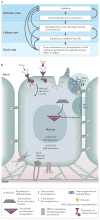The interplay between cell signalling and mechanics in developmental processes
- PMID: 24045690
- PMCID: PMC4056017
- DOI: 10.1038/nrg3513
The interplay between cell signalling and mechanics in developmental processes
Abstract
Force production and the propagation of stress and strain within embryos and organisms are crucial physical processes that direct morphogenesis. In addition, there is mounting evidence that biomechanical cues created by these processes guide cell behaviours and cell fates. In this Review we discuss key roles for biomechanics during development to directly shape tissues, to provide positional information for cell fate decisions and to enable robust programmes of development. Several recently identified molecular mechanisms suggest how cells and tissues might coordinate their responses to biomechanical cues. Finally, we outline long-term challenges in integrating biomechanics with genetic analysis of developing embryos.
Figures



References
-
- His W. On the principles of animal morphology. Proceedings of Royal Society of Edinburgh. 1888;15:287–298.
-
- Rhumbler L. Zur mechanik des gastrulations vorganges insbesondere der invagination. Archiv Fur Entwicklungs mechanic. 1902;14:401–476.
-
- Morgan TH. Experimental Embryology. Columbia University Press; 1927.
-
- Lewis WH. Mechanics of Invagination. Anatomical Record. 1947;97:139–56. - PubMed
-
- Howard J. Mechanics of Motor Proteins and the Cytoskeleton. Sinauer Associates; Sunderland, MA: 2001. p. 367.
Publication types
MeSH terms
Grants and funding
LinkOut - more resources
Full Text Sources
Other Literature Sources

